Buenos Aires
It was a long sixteen hour flight from Sydney to Buenos Aires, which was not much fun in economy class but at least I had a window seat and no one in the middle. On arrival at the airport I caught a bus into the city centre and booked into the Bristol Hotel, an old fashioned and expensive hotel on Cerrito Avenue. My room had a nice view overlooking the obelisk, which was located in the middle of the widest avenue in the world. In fact the avenue is so wide you have to run to get across it in just one set of lights. Buenos Aires is a rather expensive place to visit, more so for Australians as the Argentine peso is tied to the US dollar. The streets are narrow and crowded with traffic so it’s better if you can walk around on a weekend as there is less traffic than during the week. The city does have a couple of pedestrian only streets where you will find lots of American style take-away food shops and Internet cafes. On Sundays many of the locals crowd into the plazas and park areas in the Recoleta district where there are street performers, musicians and market stalls. The Recoleta cemetery nearby is an interesting, if morbid, place to visit due to the unusual architecture of the family mausoleums. As I had plenty of time in Buenos Aires I took the opportunity to do some cultural activities such as visiting museums and art galleries. I even took a tour of the pink coloured House of Government on Plaza De Mayo. Unfortunately I had to take the Spanish speaking session. As I had not brushed up on my Spanish language skills before the trip, I didn’t take a great deal in. I had an excellent English speaking tour of the Colon theatre so no problems with that tour. Mind you, it’s surprising how much you can remember when you are ordering a cheese burger and you have no choice but to make yourself understood in Spanish. The La Boca district was rather disappointing – too touristy for my liking.
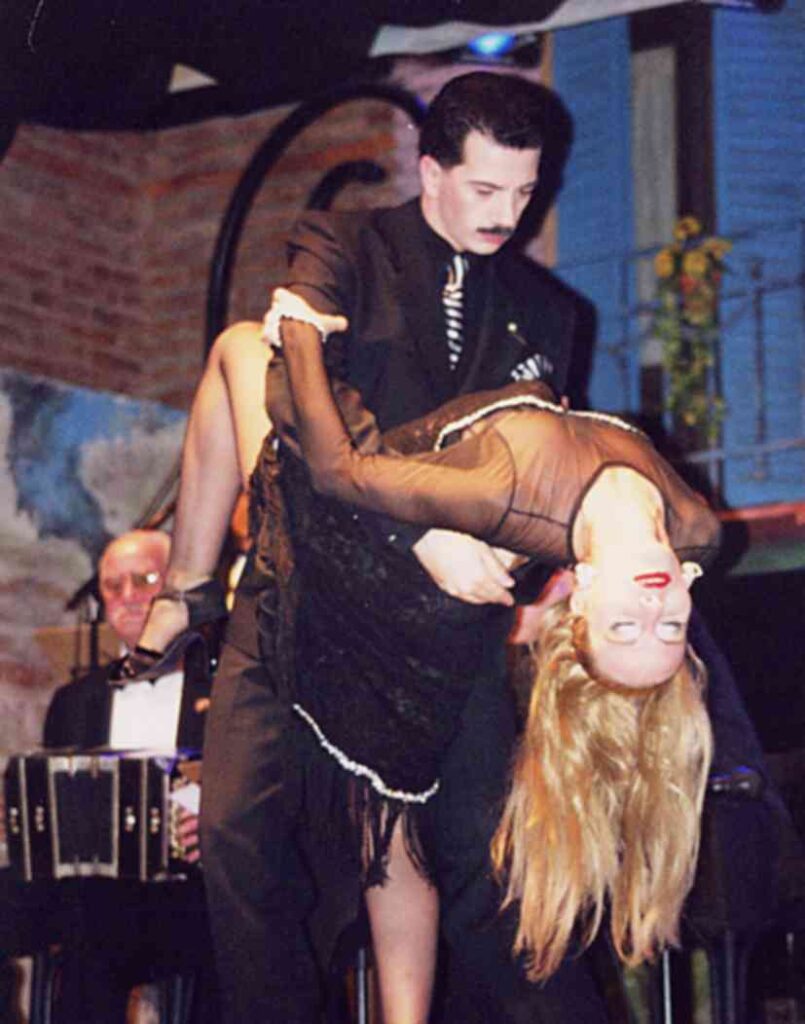
Tango, Mate and Gaucho’s
Of course one does not visit Buenos Aires without attending a tango dance show. I went to La Ventana, which cost US$70 for the show and a superb dinner, including wine. I was seated with an Australian couple from South Australia and we were fortunate to have a table close to the stage. What a fantastic show it was, one of the best two hours of entertainment I have ever experienced. Great musicians, attractive dancers and a terrific Indian folk band called “Hermanos Lamas”. The girls wore very revealing dresses and the way they flicked their legs up between their partner’s legs was amazing …and terrifying. The next day was spent visiting a Gaucho ranch called “Santa Susana” located an hour or so north of Buenos Aires. An enjoyable excursion but a bit touristy. Sylvia, our hostess for the day, wore a cowboy hat but she later admitted that she doesn’t ride horses. We had Mate on board the bus while travelling to the ranch, the traditional Argentine herb drink. It tasted like burnt tea so I had to eat a sweet milky biscuit (more traditional fare) to get rid of the taste. There was the opportunity for some horse riding before lunch while a huge variety of meat was cooked slowly over hot coals. Not a bad lunch, plenty of meat of course, as they love their meat in Argentina. The beer was good – can’t say the same for the red wine. There was also entertainment during lunch with singing, tango dancing (an old man with a gorgeous girl) and this gaucho who was swinging ropes with rocks attached and bouncing/skipping them on the boards. I know that’s a really hopeless description but it was an amazing act. Afterwards it was outside for a macho horse riding display by the Gaucho’s.

Next I flew up to Iguassu Falls for a couple of days. I couldn’t get into the Sheraton Hotel as I left my hotel booking quite late and I soon found out why. On the flight I was speaking with the lady sitting next to me and discovered she was part of an Avon convention, and guess where they were all staying … the Sheraton Hotel. Iguassu Falls were very impressive and the weather was great for photography. It was noticeably hotter up there but luckily the hotel had a pool. Unfortunately, I picked up a nasty flu virus which got worse with each day. I spent over half a day on the Brazilian side of the falls which is definitely worth the effort as you get a different perspective and great views of the falls. I returned to Buenos Aires for another two days and then a five hour flight to Lima, though it seemed longer as I was now starting to feel quite unwell with flu symptoms. There was a lady with her grandson on the other side of the plane. She must have given him too many lollies or sweets as he threw up all over the place. I nearly followed suite. The only good thing about the flight was the spectacular sunset. A World Expeditions (WE) representative met us at the airport and I also had the chance to meet other people on various WE trips. Our hotel for the first night of the trip was in the Miraflores district, one of the safer areas of Lima. The next day we visited the gold museum, which was an amazing place with so many artefacts it was hard to take it all in. Luckily we had an excellent guide, Ramon, to show us around the museum and explain various items to us. Afterwards it was off to “La Farmacia” to buy some anti-biotics and endure another restless and feverish night.
Cusco
The next day it was an early start for our short and exhilarating flight to Cusco (3,400m). We also met our WE guide for the next three weeks, Williams, who was a local guy from Cusco. Our arrival in Cusco coincided with a three day religious festival so there was plenty of dancing, singing and processions, as well as lots of noisy fireworks. As some in our group can testify, beware of kids dressed as charging bulls emitting fireworks. We also had an earth tremor late one night but luckily it was only a minor one. I decided to miss the city bus tour to rest at the hotel and take some more anti-biotics (must of had the 1st anti-biotics too early). At one stage I was starting to think perhaps I would not be able to go trekking but the new anti-biotics took almost immediate affect. So good in fact that I was able to participate in the walking tour of Cusco the next day. There were no problems waking up on time during the festival as the firecrackers usually started from 6am onwards. Leaving the hotel and running the gauntlet of shoe shine boys we first visited the cathedral, which was under restoration and probably always will be due to the frequent earth tremors. Then we visited the local markets, where I bought a cheap but distinctive and colourful woollen beanie. We also met some of Williams’ relatives in the produce market. Then it was time to leave the wonderful city of Cusco and enter the Sacred Valley of the Incas and get used to living out of a duffle bag for the next ten days. We had a rushed tour of the ruins above P’isac, which contained fortress structures, temples and good views of the Sacred valley. Lunch was at a tourist restaurant near Calca and afterwards we visited the ruins at Ollantaytambo. The Sun and Moon temples at these ruins were made from huge smooth blocks of rock and were very impressive. We stopped off at a nice pottery shop, called Pablo Seminario, on our way to the hotel where it was our last chance to get a good nights sleep in a warm comfortable hotel bed before the trek started. There were lovely mountain views as we departed Yucay and climbed up the hill and headed to the trailhead at Mollepata to commence our trek.
The Inca Trail trek begins
The dirt road up the hill to Mollepata was almost 4WD territory but the bus somehow made it up the trail in one piece. We had a relaxing picnic lunch before setting off to our first campsite. During this first part of the trek our gear was carried by horses and mules. The people on our trip were, Sue, Peter & Robert from Melbourne, Nita from Sydney, Linda and Qentin from Scotland, Pauline and David from England, Terri and Carol from America. As we were starting our trek from Mollepata we had the trail almost to ourselves and didn’t see many other tourists until we reached the main Inca trail five days later. The stars are so bright and clear when camping in the mountains and we saw quite a few shooting stars and satellites.

We had snow falls on the second day of our trek and I was thinking … oh no, not again (we were snowed in for 3 days last year at Machhermo in Nepal). We arrived at Ichupata campsite (4,400m) with the snow still falling and huddled inside the dining tent while waiting for our tents to be put up. It reminded me of bingo – “number 17, your tent is ready”. But the snow eventually stopped falling late in the afternoon and the clearing weather gave us a chance for great views of Salcantay mountain (6,271m). It also meant a rather cold night in the tents. After dinner our guide Williams made an offering to the Mother Earth, Salcantay (The Maker of the Skies) and Humantay on a nearby hill. The next morning we heard and saw quite a few avalanches on the mountain following the snow falls from the previous day. Our highest pass, Incachiriasca at 4,870m, was also our first pass so it was a slow and steady pace up the trail to the pass. Once everyone had reached the top of the pass Williams brought out some special “medicine” (also known as schnapps) to celebrate our successful ascent. We had two nights at our next campsite at Acombamba, which gave us the opportunity for a rest day and catch up on some washing – especially our hair. Some of us decided to be energetic and spent half of our rest day climbing up to Palcay Pass (4,730m). We didn’t stay at the pass for too as it was cold and windy and even started snowing at one stage. There was a fair bit of snow near the top of the pass and on our way back down we had a lot of fun taking giant steps as we bounded down the snow covered slope. Or you could slide down on your backside in an uncontrolled fashion, like Peter did, and give the guide a heart attack. You could also do the big step thing on the shale rock covered slope but I wouldn’t recommended it if you have recently purchased new hiking boots. The worst part of the optional excursion was climbing up the steep hill to get back to the campsite. So much for resting. We returned to find the girls in the dining tent drinking whisky and dancing to music. I don’t know…you leave them alone for three hours and look what happens. In the afternoon we had a traditional feast, called a Pachamanca, where they heat up rocks and cook the potatoes and marinated lamb in the ground. What a fantastic meal. The meat was just delicious. After my third helping I think you could safely say that my appetite had returned. We also drank lots of cheap red cask wine with the 99 vintage in particular being quite outstanding. Another cold night in the tents as evidenced by the snow and ice on the ground the next morning.
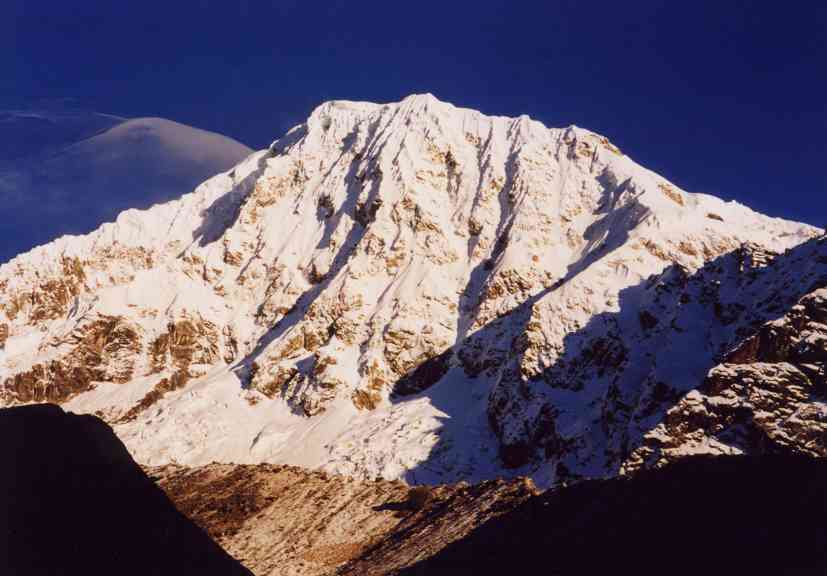
A pleasant morning meant we were able to have breakfast outside the dining tent in the sunshine with a superb view of Salcantay. As Terri would say, awesome !!! It doesn’t get much better than this. We said our farewells to Carol, who was not well and was heading back to Cusco via horse and bus. She would join up with the group later at Machu Picchu. Our last campsite, before joining the main Inca trail, was amongst the Inca ruins at Paucarcancha (3,050m). We also met our porters for the next five days who were dressed in colourful ponchos for the group photo shoot. Horses and mules are not allowed on the main Inca trail due to the damage they cause to the trail. Once we joined the Inca trail proper we encountered lots of other trekkers, including a German group who we kept bumping into for the next few days. Yes, lots of jokes about defences, tactics and campsite invasions. They turned out to be really nice people. As in Nepal there was lots of ups and downs and lots of steps. We did quite a lot of optional walks thanks to Williams, our enthusiastic guide. The food was great and quite varied. Having done two treks with WE before I wasn’t surprised when they served up popcorn during afternoon tea. Most nights everyone was in bed by 8-00 or 8-30pm. Some of us would try and stay up longer for some joke telling before finally succumbing to the cold and tiredness. The next high pass was Warmihuanusca (4,198m) also known as “Dead Women’s Pass”. Nothing like a good steep climb to start off the day’s trekking. A group photo session at the top of the pass as well as some “medicine” to celebrate.
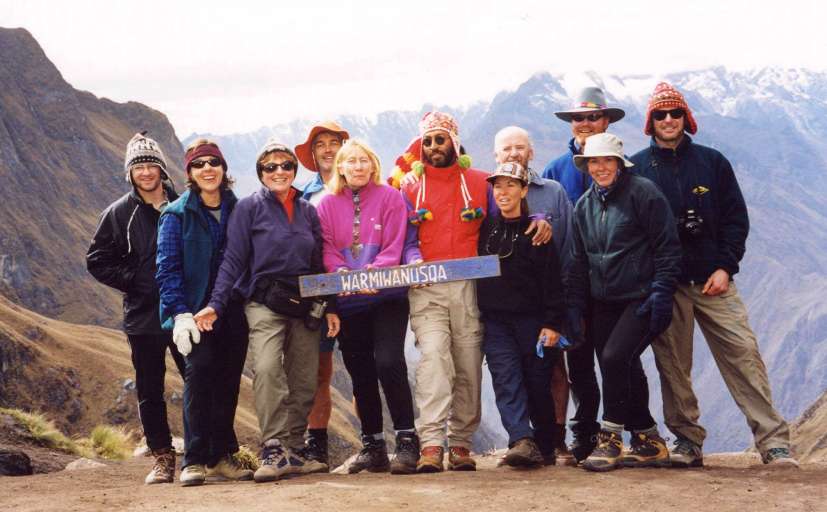
City in the Clouds
One of the best campsites along the trail was above the Inca ruins at Runkaraquaycasa, called the “City in the Clouds”. Our tents were perched high on the mountain side on any little piece of available flat ground with magnificent views of the valley below us. The place wasn’t called “City in the Clouds ” for nothing as there was quite a lot of cloud around in the afternoon which made photography difficult. Anyway, I went down to the ruins below our campsite in the afternoon and with a bit of patience I managed to get some decent photos. Unfortunately, if you go down to visit the ruins you then have to struggle back up via lots of steep steps to return to the campsite. I arrived just in time for a late afternoon walk (more exercise) up a hill to the highest point of the campsite where we had fantastic panoramic views of the surrounding area, including the last mountain ridge which hid Machu Picchu from our view. Then just after sunset the clouds disappeared and we had wonderful views of Salcantay mountain. Vegetarian Spaghetti Bolognese for dinner and everyone had “yappa” (also known as Yabba Dabba Do) or seconds. We also had some beers with dinner which one of the porters fetched from the nearest village, just down the trail so to speak. Some Americans filed past our dining tent with their miner’s lamps on their heads and someone started singing the Disney song “Hi ho, hi ho, it’s off to work we go, with a spade and a shovel and great big stick…” Then we sang that song every time we saw them. Luckily they had a sense of humour. An early start the next morning to catch sunrise and we were well looked after by the porters with tea and biscuits. We had a brief visit of the Winay Wayna ruins which were very well preserved as they were only discovered in 1942.
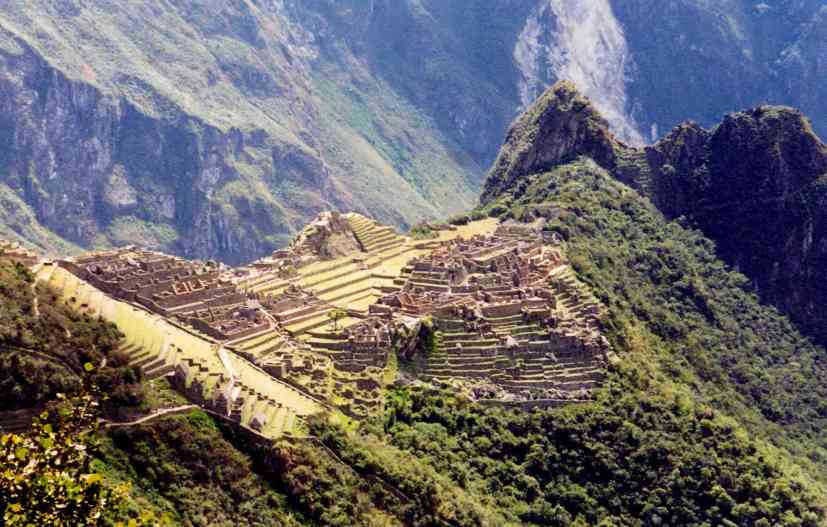
Lost Incan city of Machu Picchu
Then it was on to our “Mecca” and one of the biggest attractions in South America, Machu Picchu. We climbed up to Inti Punku (Gateway to the Sun) just after lunch time and indeed the hot sun was shining down upon us. That first view of Machu Picchu as you pass through Inti Punku is just breath-taking, absolutely amazing. It’s easy to see why the Inca’s picked this site as the setting is just magnificent. A lot of tourists arrive at Machu Picchu via the train and bus, however, I think there is greater satisfaction and adventure in arriving at Machu Picchu via the Inca trail. It was such a magical experience. After eating lunch we then descended down the trail to the ruins where we found Carol waiting for us. The family of the Southern Cross was one again. “La familia del Sur Cruz” was now our group nickname. After a few quick photographs of the ruins we continued down to the car park to catch a bus to the township below. The dirt road to the ruins is quite steep with lots of bends and there are these young children in traditional clothing who take turns to run down the hill, waving and yelling out adios as the bus passes them. Then they run down to the next spot and they keep this up all the way down to the bottom where they board the bus to receive tips. Quite impressive but I couldn’t help thinking the bus company was in on it. As the trek had now finished and we were back in hotels it was time to have a shower and a few drinks or should I say a lot of drinks. All the hotels, restaurants and shops have sprung up around the train line which made the place feel somewhat bizarre. Even more bizarre and frightening was watching the over-crowded train depart with people hanging on outside and in between the carriages. We shared some pizzas for dinner including a three seasons pizza (not sure what happened to the fourth season). After dinner some of us went across the railway line and up to the plaza to watch a few bands playing Andean folk music in a concert sponsored by the Japanese.
Exploring Machu Picchu
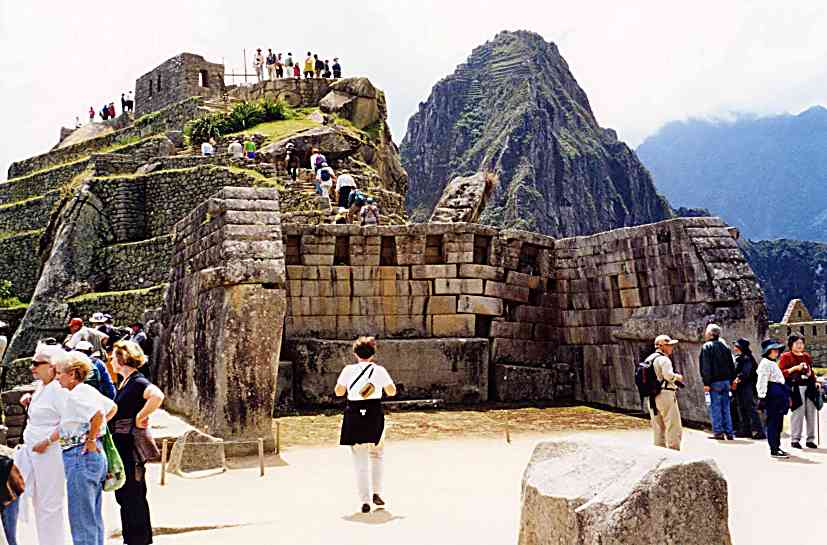
The next day we spent four hours exploring the extensive ruins, with Williams providing his usual expert and interesting commentary. We started reasonably early so as to avoid the hoards of tourists who arrive by train. The Incan city was never discovered by the Spaniards and lay covered by jungle for centuries. Hiram Bingham eventually found the ruins in 1911. It’s a very tranquil and relaxing place. There is even a large grassy area that you can rest on and just watch the llamas grazing. Then it was back into town for a superb buffet lunch, in which I pigged out big time, including several pisco sour drinks. After lunch and a brief downpour of rain, it was time for the slow and bumpy five hour train ride back to Cusco. One of the first things we did upon our return was to send our dirty washing to the laundry. Then it was off for a hamburger and fries at Bananos Café and then a few drinks at an English style pub. It was great to see on the Fox Sports TV channel that the Wallabies had beaten the Springboks by one point to win the Tri-Nations.
Guinea Pig Lunch
The next day Williams organised a Guinea Pig lunch for us at a nearby restaurant. Before serving the meal, they brought the cooked pigs out whole for a photo shoot and I am sure some of the group started having second thoughts. I suppose it’s worse if you had them as pets when you were young. Anyway the meat was quite nice, tasted a bit like chicken (don’t we say that about all unusual meat ?) and I even found the crunchy claw was edible, much to Qentin’s disgust. We had another long and slow train ride from Cusco to Juliaca. Not a great deal to view scenery wise on the train ride. Going to the toilet was an experience and quite dangerous as the train often lurched from side to side. Having a light bulb just above the toilet on the low ceiling wouldn’t win any interior design awards. Luckily I had bought some local souvenir cards, so Pete, Robert, Sue and myself played 500 for a while before having lunch on the train. The highest point on the rail trip was at a place called La Raya (4,313m) where we had views of snow capped mountains.
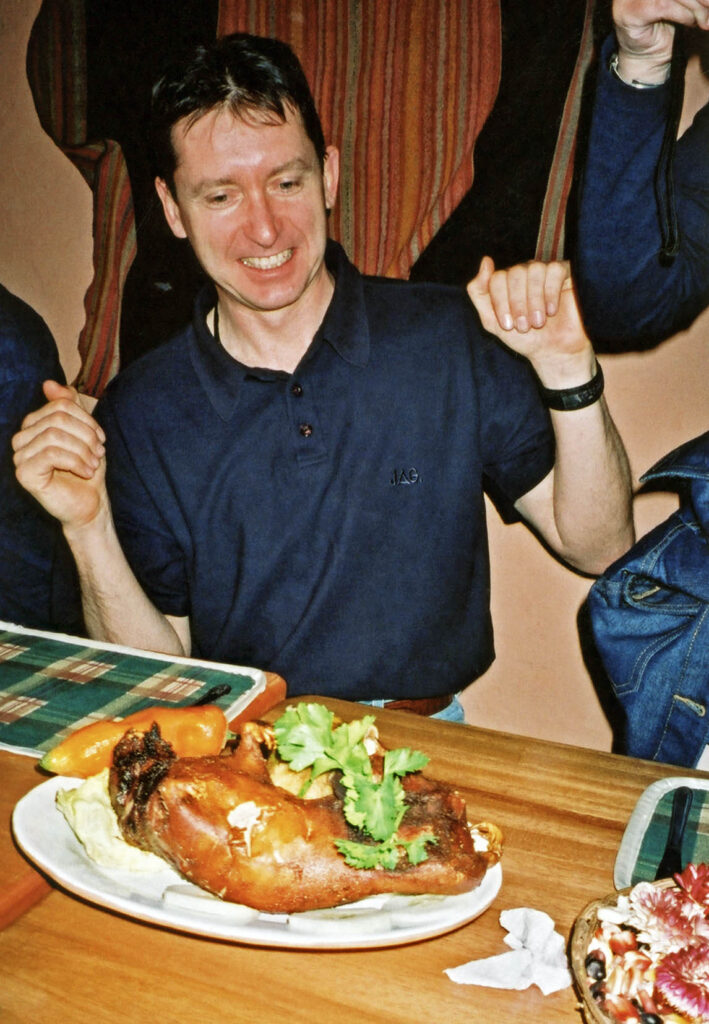
Puno
Our hotel was about 30 minutes out of Puno and had distant views of Lake Titicaca. It also had artificial rock style walls and these bizarre bird sculptures on top of the roof which were meant to be condors but looked more like vultures. Nothing bizarre about the hotel restaurant where most of us had trout for dinner. For our first excursion we drove about an hour out of Puno and visited the interesting Sillustani ruins that contained “Chulpas” or burial towers, both Inca and pre-Inca towers. Unlike the Spaniards, the Inca’s didn’t go around destroying sacred buildings built by previous civilisations. However, lightening strikes had done a lot of damage to the towers over the years. One of the round Inca burial towers had not been completed and it had a ramp to one side with pre-fabricated rocks laid out in orderly lines on the ground around the structure. It was a great insight as to how they built the towers.

Lake Titicaca
On the second excursion we took a boat out to the floating tortora reed islands on Lake Titicaca where the Uros Indians live. When you arrive on the reed islands the children sing the same song over and over, but in different languages. Some of the reed islands were quite large and one even had a small school building. Apparently their spartan existence revolves around eating and exchanging fish for goods and relying on the tourist dollars. Back to the hotel for another superb meal at the restaurant. This time it was a bowl of soup served with a separate bowl of cooked lamb, potatoes, peaches, apples, parsnip, cabbage, tomato, onion. You cut up the ingredients, put them in the soup and away you go. Very tasty and very filling. Then it was across the border to Bolivia where we stopped for lunch at Copacabana, on the shores of Lake Titicaca. The peanut soup (like a chowder without seafood) and the kingfish were delicious. The Pacena beer was not quite as good as Cusquena beer. The good news was that the exchange rate for Bolivia was twice that of Peru, which meant cheaper eating, drinking and shopping.
La Paz
The rest of the afternoon was spent travelling to La Paz, which is the highest capital city in the world at 3,900 metres. We stayed at the Hotel Gloria and after travelling all day decided to have a late dinner in the hotel restaurant, which had superb nightscape views of the city. I had scallops for my entrée and a thick rump steak for mains but sadly could find no room for dessert. However, the highlight of dinner was the Irish coffee and not just the coffee itself but the entertaining way the waiter made the drinks in front of us. Especially when he poured in the blue flaming contreau. Afterwards we headed off in taxis to Wayki’s bar for a few beers and a night of retro rock music. We also drank one of the locals favourites, a big bucket of unknown but sweet tasting intoxicating ingredients that we drank from with straws. The next day our local guide, Carlos, took us on a walking tour of La Paz. We visited the Plaza de Armos, Casa de Murillo which included a very good museum containing lots of Inca gold artefacts, San Francisco church and the tourist market area. Even though we had been at altitude for a while we still had to walk slowly up the hills around La Paz as you run out of breath quite quickly.
Tiwanacu Ruins
Some of us took an optional excursion to the Tiwanacu ruins about an hour and twenty minutes out of La Paz. These ruins are an amazing place yet surprisingly very little of the site has been excavated. The Tiwanacu race existed before the Inca’s and it is obvious they passed on some of their stone masonry knowledge to the Inca’s. Our guide said that archaeologists had not found any stone carving tools at the site so they are not sure how the Tiwanancu race shaped the large rocks. The most amazing thing we saw, or heard to be more precise, was a primitive megaphone in one of the stone walls. They had carved out the shape of the inner ear inside the rock and it really worked because we tried it out. You could talk normally through it from the other side of the wall and people thirty feet or more could clearly hear you. If you put your ear inside you could hear the group quietly talking to themselves.
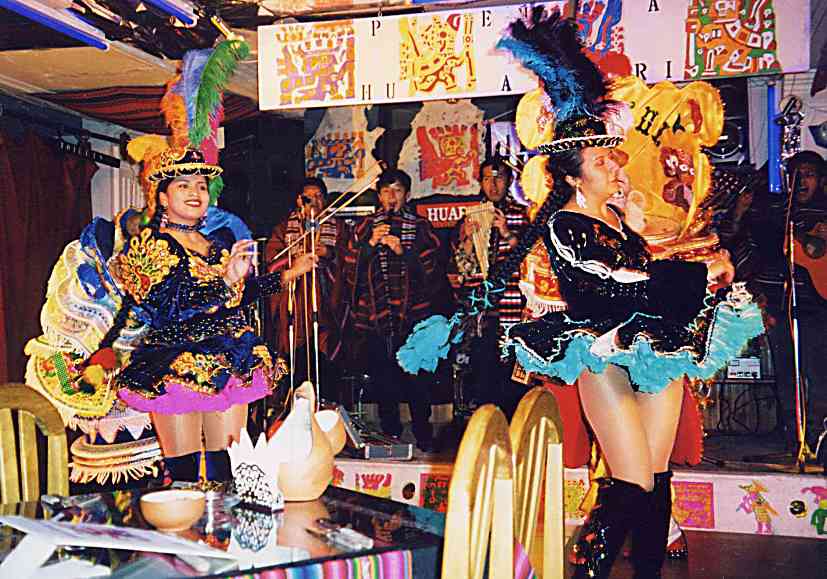
Folk dancing and free tequila
For our last night in La Paz we went to a fantastic folk dancing, music and dinner show. The Andean folk music was superb and the costumes of the dancers were very colourful and at times quite bizarre. Of course there was a lot of audience participation in the dancing which was great fun but very tiring. Afterwards it was back to the Wayki’s bar for the third and last night. Lots of beer, free whisky and free tequila. When traditional Andean folk music songs were played some energetic young locals would get up and do this amazing traditional folk dancing. It was a spectacular display of dancing which had the whole place captivated. That the two girls dancing were gorgeous had nothing to do with it.
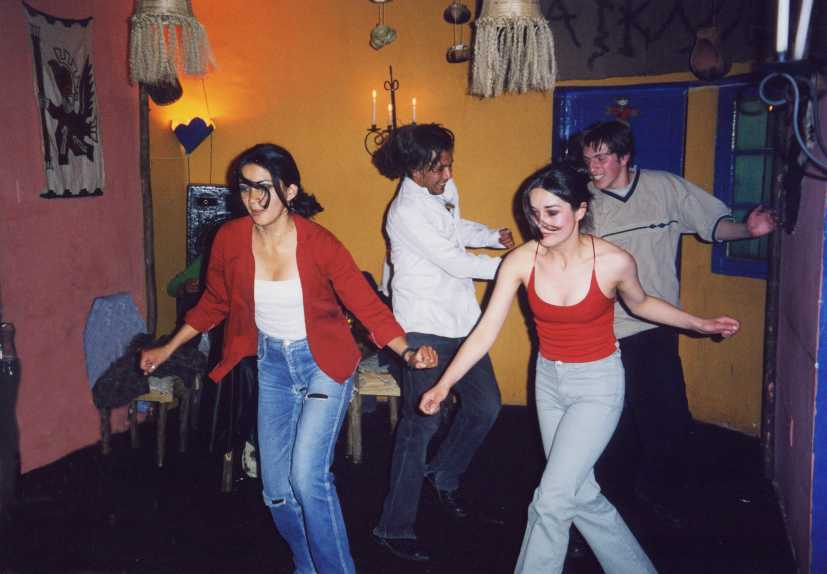
Back to Australia
Well there’s nothing like a massive hangover when flying out of a country. The flights were quite rough and I only just managed not to embarrass myself. I had a stopover in Buenos Aires for a day before heading home to Australia. We had some of the Brazilian Olympic squad travelling with us on the plane and they were quite well behaved, except for one time when some of the athletes decided to swap seats just before the plane was about to accelerate down the runway for take-off. The crew were not amused. After arriving at Sydney airport, Customs officials set the sniffer dogs upon us searching for drugs, which the Brazilians found highly amusing. My mate Brett picked me up from the airport and we went home and had gourmet pies and beers for lunch and listened to my Andean music CD’s that I had bought in La Paz. The body clock took a while to re-adjust to the time differences. I first woke up at 1-30am, then 4-30am for a few mornings and then eventually back to normal. Well the end of another fantastic adventure and I have now chalked up 50 countries, which has always been a goal of mine since leaving High School … many years ago. Until next time, happy and safe travelling. Adios amigos.